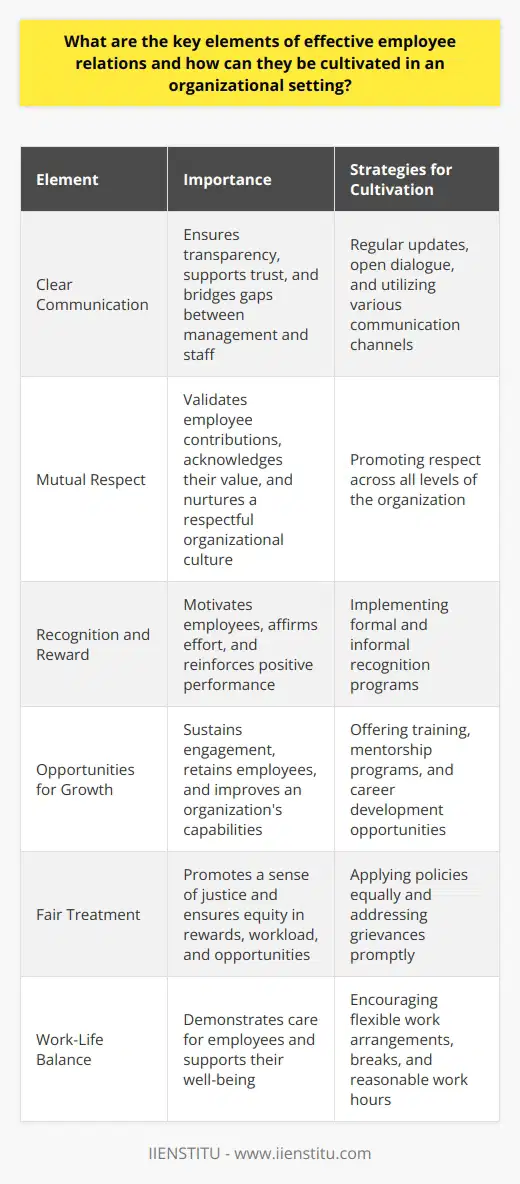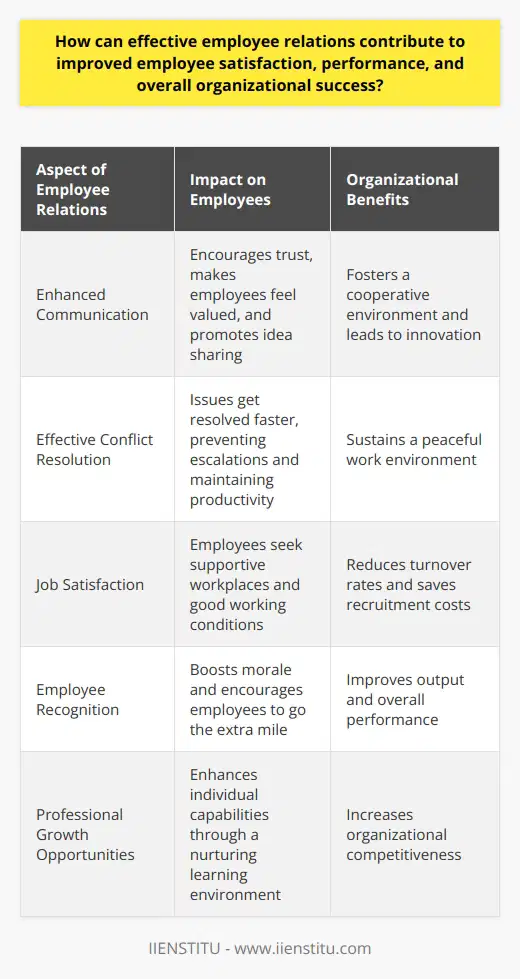
Understanding the Essence of HR Employee Relations Training
In the intricate tapestry of modern business, where the threads of human interactions intertwine to create the fabric of success, HR Employee Relations Training emerges as a paramount force. It is a beacon illuminating the path towards a harmonious workplace, where the gears of productivity mesh seamlessly with the cogs of employee satisfaction. As someone who has witnessed firsthand the transformative power of effective HR training, I am compelled to delve into the depths of this subject, to unravel its complexities and reveal its profound importance.
At its core, HR Employee Relations Training is a multifaceted endeavor, encompassing a myriad of strategies and techniques designed to cultivate a positive, productive, and legally compliant work environment. It is a discipline that demands a deep understanding of human psychology, a mastery of communication skills, and a keen awareness of the ever-evolving legal landscape. As Deborah Tannen aptly states in her book "Talking from 9 to 5," "The way we communicate is as important as the words we say." This sentiment lies at the heart of HR Employee Relations Training, emphasizing the crucial role of effective communication in fostering a healthy workplace dynamic.
Definition of Employee Relations
Employee relations encompasses the manifold interactions between an employer and its workforce, ranging from collective bargaining agreements to individual employment advocacy. At its core, it seeks to establish and maintain a rapport built on trust, respect, and fair practice. Embedded within are the elements of communication, conflict resolution, and legal compliance, which conspire to foster a synergetic organizational culture.
Purpose and importance in the organization
The import of robust employee relations can hardly be overstated; it is a fundamental determinant of organizational health. Businesses that prioritize these relations tend to report enhanced job satisfaction, greater innovation, and superior financial performance. As such, this sphere is integral to the strategic framework that encapsulates both human resource and broader business goals.
The role of HR in Employee Relations
Human Resources serves as the vanguard for nurturing positive employee relations. This department is tasked with sculpting policy, moderating dialogue between staff and management, and preemptively resolving disputes that, if left unchecked, could metastasize into far-reaching discord. The proverbial toolkit of an HR professional is replete with skills and policies crafted to engender cohesion and a positive organizational ethos.
Communication Skills
Importance of effective communication in Employee Relations
In the rich tapestry of employee relations, effective communication acts as the warp and weft. It is the vehicle for conveying policy, feedback, and appreciation—elements that have a tangible impact on job satisfaction and productivity. HR online course offerings frequently underscore this facet, recognizing its elemental status in the HR domain.
Training methods for improving communication skills
Investing in online courses to hone communication proficiency is both a pragmatic and accessible strategy for those in the field of HR. Training methodologies might encompass interactive simulations, role-playing activities, and workshops underscored by reflective practice, all designed to actualize the theoretical underpinnings of effective communication.
Conflict Resolution
Role of conflict resolution in Employee Relations
Few aspects of employee relations carry the weight that conflict resolution does. It is where the theoretical meets the practical, as HR professionals apply their acumen to defuse potential flashpoints that can sabotage an organization's morale and output.
Training methods for improving conflict resolution skills
Conflict resolution skills are cultivated through scenario-based training and real-world case studies that illuminate the nuances of employee conflicts. Through online courses crafted to replicate workplace dynamics, HR practitioners can assimilate the requisite finesse to negotiate resolutions effectively.
Treatment of Employees
The impact of fair treatment on Employee Relations
Fair treatment of employees is the bedrock upon which sustainable employee relations rest. It instills a sense of equity and belonging among the workforce, which, in turn, drives engagement and retention.
Training techniques to ensure fair treatment
Training in this dimension often involves sensitization to diversity, implicit bias awareness, and a deep dive into ethical practices within the HR function. It is through these inculcative experiences that HR personnel can effectively champion the cause of fair treatment across an organization’s demographic.
Understanding Labor Laws and Standards
Importance of legal knowledge in managing employee relations
Navigating the labyrinthine landscape of labor laws and standards is indispensable when managing the intricacies of employee relations. This legal acumen not only ensures compliance but also safeguards the organization against prospective litigation.
How training can keep HR personnel informed about the legal standards
Continuous legal education via training programs ensures that HR professionals remain vigilant and informed about evolving regulations. Such online courses often delve into case law, statutory amendments, and regulatory updates, keeping HR at the forefront of legal preparedness.
Enhanced Employee Engagement
Employees are more likely to be invested in their roles and exhibit discretionary effort when they feel their employer is reciprocally engaged with their well-being and professional development. Training in employee relations empowers HR professionals to be the architects of such engagement.
Retention of Talents
The nexus between well-executed employee relations training and talent retention is well-documented. When employees perceive that their grievances are heard, and their contributions are valued, their propensity to remain with an organization swells.
Promoting Positive Workplace Environment
An environment bristling with positive interactions is not only conducive to employee well-being but becomes a self-reinforcing cycle of productivity and job satisfaction. Training in employee relations necessitates mastery in creating and maintaining such an environment.
Minimizing Legal Risks
Robust training in employee relations is synonymous with a reduction in legal confrontations. Knowledgeable HR practitioners are adept at navigating the complexities of employment law, circumventing issues that could potentially escalate into legal entanglements.
But what exactly does this training entail? At its foundation, it involves equipping HR professionals with the tools and knowledge necessary to navigate the complex terrain of employee relations. This includes:
1- Developing *robust communication skills* to facilitate open and transparent dialogue between employees and management.
2- Honing *conflict resolution techniques* to address and resolve workplace disputes in a fair and timely manner.
3- Ensuring fair treatment of all employees, regardless of their background or position within the company.
4- Maintaining a *deep understanding of relevant labor laws and standards* to ensure legal compliance and minimize the risk of costly litigation.
The importance of these aspects cannot be overstated. As David Ulrich and Wayne Brockbank note in their book "The HR Value Proposition," "HR practices that enhance employee commitment and competence are key to creating value." By investing in comprehensive HR Employee Relations Training, organizations can unlock the full potential of their workforce, driving engagement, productivity, and ultimately, success.
But the benefits of this training extend far beyond the realm of employee satisfaction. A well-trained HR department can serve as a strategic partner to the business, aligning its practices with the overall goals and objectives of the organization. This alignment is crucial, as it allows HR to play a proactive role in shaping the company's culture, attracting and retaining top talent, and fostering a sense of shared purpose among employees.
Moreover, effective HR Employee Relations Training can help to mitigate the risk of legal entanglements, which can be both costly and damaging to an organization's reputation. As Barbara Mitchell and Cornelia Gamlem explain in their book "The Big Book of HR," "HR professionals must be knowledgeable about employment laws and regulations to ensure that their organizations are in compliance." By staying up-to-date with the latest legal developments and best practices, HR can help to navigate the complex web of regulations governing the workplace, minimizing the risk of costly mistakes.
Of course, the success of any HR Employee Relations Training program depends on its ability to adapt to the unique needs and challenges of the organization it serves. A one-size-fits-all approach is rarely effective, as each company has its own distinct culture, values, and goals. As such, it is essential for HR professionals to tailor their training programs to the specific needs of their organization, taking into account factors such as industry, size, and geographic location.
John Maxwell, in his book "The 5 Levels of Leadership," emphasizes the importance of continuous improvement and growth, stating that "Change is inevitable. Growth is optional." This principle applies equally to HR Employee Relations Training, which must evolve and adapt to keep pace with the rapidly changing business landscape. By regularly reviewing and updating their training programs, HR professionals can ensure that they remain relevant and effective, even in the face of new challenges and opportunities.
Furthermore, incorporating feedback from employees is a crucial aspect of any successful HR Employee Relations Training program. By actively seeking out and listening to the perspectives of those on the front lines, HR can gain valuable insights into the real-world challenges and opportunities facing the organization. This feedback loop allows for continuous improvement and refinement of training initiatives, ensuring that they remain aligned with the needs and expectations of the workforce.
In my personal experience, I have witnessed the transformative power of effective HR Employee Relations Training firsthand. In one particularly memorable instance, I worked with a client who was struggling with high levels of employee turnover and low morale. By implementing a comprehensive training program that focused on improving communication, resolving conflicts, and promoting fair treatment, we were able to turn the tide. Within a matter of months, employee engagement skyrocketed, productivity soared, and the company's bottom line began to reflect the positive changes.
But the impact of this training extends beyond the confines of the workplace. By fostering a culture of respect, empathy, and open communication, HR Employee Relations Training can have a ripple effect that extends into the broader community. As employees take the skills and values they learn at work and apply them to their personal lives, they become agents of positive change, contributing to a more harmonious and connected society.
In conclusion, HR Employee Relations Training is not merely a business imperative; it is a moral and ethical obligation. By investing in the development of our human capital, we are investing in the future of our organizations, our communities, and our world. As Simon Sinek so eloquently puts it in his book "Start with Why," "Customers will never love a company until the employees love it first." Let us embrace this truth and make HR Employee Relations Training a cornerstone of our organizational strategies, building a foundation of trust, respect, and mutual understanding that will propel us forward into a brighter, more prosperous future.
References:
1- Tannen, D. (1995). Talking from 9 to 5: Women and Men at Work. William Morrow and Company.
2- Ulrich, D., & Brockbank, W. (2005). The HR Value Proposition. Harvard Business Press.
3- Mitchell, B., & Gamlem, C. (2012). The Big Book of HR. Career Press.
4- Maxwell, J. C. (2011). The 5 Levels of Leadership: Proven Steps to Maximize Your Potential. Center Street.
5- Sinek, S. (2009). Start with Why: How Great Leaders Inspire Everyone to Take Action. Portfolio.
Frequently Asked Questions
What are the key elements of effective employee relations and how can they be cultivated in an organizational setting?
Keys to Effective Employee Relations
Effective employee relations are critical. They determine an organization’s health. Good relations foster a positive work environment. Such environments enhance productivity. Several key elements drive effective employee relations.
Clear Communication
Communication is foundational. It bridges gaps between management and staff. Clear communication ensures transparency. It supports trust. Regular updates and open dialogue are essential. Use various channels for messages. Face-to-face, email, and internal platforms work well.
Mutual Respect
Respect is non-negotiable. It validates employee contributions. It acknowledges their value. Mutual respect across all levels is vital. It nurtures a respectful organizational culture.
Recognition and Reward
Positive reinforcement is powerful. Recognize and reward good performance. They motivate employees. They affirm effort. Both formal and informal recognition are valuable.
Opportunities for Growth
Growth sustains engagement. Offer training and mentorship programs. Career development opportunities retain employees. They also improve an organization's capabilities.
Fair Treatment
Fairness promotes a sense of justice. Apply policies equally. Address grievances promptly. Ensure equity in rewards, workload, and opportunities.
Work-Life Balance
Balance is critical for well-being. Support flexible work arrangements. Encourage breaks and reasonable work hours. These demonstrate care for employees.
Strong Leadership
Leaders set examples. Effective leaders inspire their teams. They embody organizational values. Leadership development programs are worthwhile investments.
Empowerment
Give employees a voice. Involve them in decisions affecting their work. Empowerment increases commitment. It also fosters innovation.
Team Building
Teams are the basic work units. Foster collaboration. Organize team-building activities. They improve relationships and performance.
Management of Conflict
Conflicts will occur. Efficiently manage them. Promote a culture where issues surface early. Swift resolution minimizes disruption.
Cultivating These Elements
To cultivate these elements, organizations must be intentional. Create clear policies. Offer training on communication and conflict management. Regularly solicit feedback. Always recognize and act upon this feedback. Support managers in their roles as mediators. Ensure they have the necessary skills.
In essence, effective employee relations are a blend of proactive strategies and responsive actions. They revolve around respect, communication, and shared goals. Optimizing these relations requires an ongoing effort. However, the benefits of a thriving, coordinated workforce are undeniable.

What strategies can be employed to enhance communication, collaboration, and conflict management in a diverse workplace setting?
Communication in a Diverse Workplace
Workplace diversity enhances creativity. It also presents communication challenges. Employees come from varied backgrounds. They carry unique perspectives and communication styles. Effective communication strategies are critical. They ensure all voices get heard.
Foster an Inclusive Culture
Open dialogue fosters an inclusive environment. Start with an inclusive culture. Encourage sharing from different perspectives. Highlight the value of diverse opinions. Establish ground rules for respectful communication. An inclusive culture promotes trust. It reduces misunderstandings among team members.
Simplify Language and Avoid Jargon
Use simple language for clarity. Avoid industry jargon and slang. Do so especially with international teams. This facilitates understanding across language barriers.
Invest in Training
Invest in regular communication training. Emphasize active listening and clarity. Practice empathy. Teaching these skills ensures better interactions. Teams become more cohesive.
Utilize Multiple Communication Channels
Different communication channels reach diverse audiences. Use email, video conferencing, and in-person meetings. Add instant messaging and collaboration platforms. Such variety ensures accessibility. It considers different communication preferences.
Collaboration Strategies
Collaboration unites diverse talents. It harnesses them toward a common goal. Diverse teams may struggle without direction. Develop strategies that support cooperation.
Define Roles and Responsibilities
Clearly define roles. Do the same for responsibilities. This streamlines collaboration. It avoids task overlap. It clarifies expectations.
Set Common Goals
Set clear, common goals. Ensure all understand these objectives. This alignment focuses collaboration. It minimizes conflicts resulting from misaligned interests.
Encourage Cross-Cultural Understanding
Cross-cultural understanding is vital. Offer cultural competency training. This improves interactions. Employees become sensitive to cultural nuances.
Promote a Team-First Attitude
Highlight collective success over individual achievements. A team-first attitude fosters unity. It encourages collective problem-solving.
Conflict Management Techniques
Conflicts are inevitable. They are more so in diverse workplaces. Deal with conflicts promptly. Use effective techniques. These maintain harmony.
Address Conflict Early
Address conflicts when they're small. Do this before they escalate. Early intervention prevents bigger problems. It maintains a positive work environment.
Listen to All Sides
Listen to all viewpoints. Do this before acting. It's essential for fair conflict resolution.
Seek Win-Win Situations
Aim for win-win outcomes. These solutions benefit all parties involved. They minimize feelings of resentment.
Provide Multiple Avenues for Resolution
Offer various conflict resolution avenues. Some prefer formal processes. Others opt for informal discussions. Options cater to different comfort levels.
Mediate with Sensitivity
Mediate with cultural sensitivity. Understand cultural dimensions that impact conflict. Mediation should respect all parties involved.
In conclusion, communication, collaboration, and conflict management are key. They ensure success in diverse workplaces. Employ these strategies thoughtfully. They will enhance workplace harmony and productivity.

How can effective employee relations contribute to improved employee satisfaction, performance, and overall organizational success?
Understanding Employee Relations
Employee relations play a vital role. They define workplace ambiance. Positive employee relations often lead to job satisfaction. Satisfied employees typically perform better. Better performance drives organizational success. A harmonious workplace attracts talented individuals. It also retains them.
The Impact of Effective Employee Relations
Enhanced Communication
Open communication encourages trust. Trust fosters a cooperative environment. Employees feel valued when heard. They share ideas more freely. This openness leads to innovation. Innovation paves the way for success.
Conflict Resolution
Conflicts are inevitable. Effective relations manage conflicts well. Issues get resolved faster. Resolutions prevent escalations. Swift conflict management upholds productivity. It sustains a peaceful work environment.
Job Satisfaction
Satisfaction stems from positive relations. Employees seek supportive workplaces. They relish good working conditions. Good conditions come from good relations. This contentment reduces turnover rates. Lower turnover saves recruitment costs.
Employee Recognition
Recognition boosts morale. Morale enhances performance. Good relations facilitate recognition opportunities. Employees strive for these opportunities. They go the extra mile. Their extra effort improves output.
Professional Growth
Opportunities for growth affect satisfaction. Growth demands robust employee relations. A nurturing environment bolsters learning. Learning improves individual capabilities. Enhanced capabilities benefit the organization. It becomes more competitive.
Better Performance
Improved relations sharpen focus. Employees concentrate better. Concentration improves work quality. Better quality means better performance. High performance leads to organizational achievements. Achievements contribute to long-term success.
Organizational Culture
Positive relations shape culture. A strong culture aligns employees. Aligned employees share common goals. They work cohesively towards these goals. Cohesion ensures sustained productivity. Longevity in productivity spells success.
The Role of Leadership
Leadership is pivotal. Leaders set relations tone. They must promote open dialogue. They encourage collaboration. They must model respectful behavior. Respect permeates the workforce. It upholds a thriving culture.
Leaders should recognize efforts. This recognition motivates employees. Motivated employees are engaged. Engagement drives high performance. High performance translates to success.
Employee Relations as a Strategic Resource
Employee relations are strategic. They provide a competitive edge. Happy employees serve customers better. Better service increases customer satisfaction. Satisfied customers are loyal. Loyal customers ensure business longevity.
A focus on relations is wise. It maximizes employee potential. It propels the organization forward. Invest in employee relations; reap rewards in satisfaction, performance, and success.



